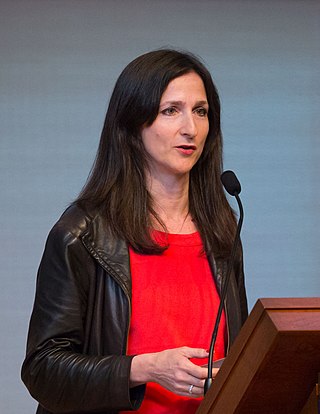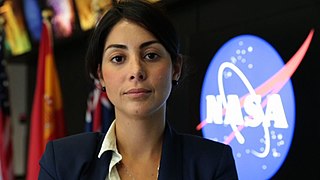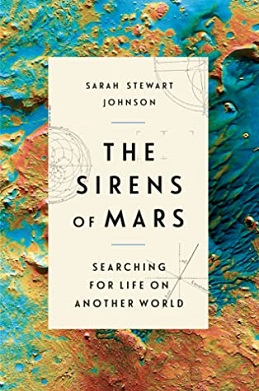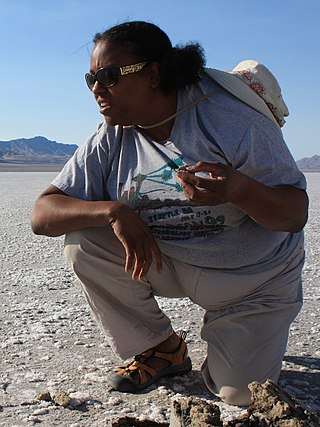Related Research Articles
A biosignature is any substance – such as an element, isotope, molecule, or phenomenon – that provides scientific evidence of past or present life on a planet. Measurable attributes of life include its complex physical or chemical structures, its use of free energy, and the production of biomass and wastes.

Sara Seager is a Canadian–American astronomer and planetary scientist. She is a professor at the Massachusetts Institute of Technology and is known for her work on extrasolar planets and their atmospheres. She is the author of two textbooks on these topics, and has been recognized for her research by Popular Science, Discover Magazine, Nature, and TIME Magazine. Seager was awarded a MacArthur Fellowship in 2013 citing her theoretical work on detecting chemical signatures on exoplanet atmospheres and developing low-cost space observatories to observe planetary transits.
The MIT School of Science is one of the five schools of the Massachusetts Institute of Technology, located in Cambridge, Massachusetts, United States. The School is composed of 6 academic departments who grant SB, SM, and PhD or ScD degrees; as well as a number of affiliated laboratories and centers. As of 2020, the Dean of Science is Professor Nergis Mavalvala. With approximately 275 faculty members, 1100 graduate students, 700 undergraduate majors, 500 postdocs, and 400 research staff, the School is the second largest at MIT. As of 2019, 12 faculty members and 14 alumni of the School have won Nobel Prizes.
Roger Everett Summons is the Schlumberger Professor of Geobiology at the Massachusetts Institute of Technology and Professor of Geobiology in the Department of Earth, Atmospheric and Planetary Sciences.

Planetary Instrument for X-Ray Lithochemistry (PIXL) is an X-ray fluorescence spectrometer to determine the fine scale elemental composition of Martian surface materials designed for the Perseverance rover as part of the Mars 2020 mission.

Sarah K. Noble is a planetary geologist and a program scientist at NASA Headquarters in Washington, D.C. Her area of expertise is space weathering processes. She was the Program Scientist for NASA's LADEE spacecraft, and is the Program Scientist for the Psyche mission.

Nathalie A. Cabrol is a French American astrobiologist specializing in planetary science. Cabrol studies ancient lakes on Mars, and undertakes high-altitude scientific expeditions in the Central Andes of Chile as the principal investigator of the "High Lakes Project" funded by the NASA Astrobiology Institute (NAI). There, with her team, she documents life's adaptation to extreme environments, the effect of rapid climate change on lake ecosystems and habitats, its geobiological signatures, and relevance to planetary exploration.
Sarah T. Stewart-Mukhopadhyay is an American planetary scientist known for studying planet formation, planetary geology, and materials science. She is a professor at the University of California, Davis in the Earth and Planetary Sciences Department. She was a professor at Harvard University Department of Earth and Planetary Sciences from 2003 to 2014.

Jessica Andrea Watkins is an American NASA astronaut, geologist, aquanaut and former international rugby player. Watkins was announced as the first Black woman who completed an International Space Station long-term mission in April 2022. On June 9, 2022, at 7:38 UTC, she became the African American woman with the most time in space, surpassing Stephanie Wilson's 42 day, 23 hour and 46 minute record.

Tanya Harrison is a planetary scientist who was until March 2023 a manager of science programs at Planet Labs, working in their federal arm with science agencies to increase research use of Planet Labs' Earth observing satellite data. Previously, Harrison was the director of research at Arizona State University's Space Technology and Science Initiative, and was on the science team of the Mars Opportunity and Curiosity rovers.

Lady Diana Trujillo Pomerantz is a Colombian-American aerospace engineer at the NASA Jet Propulsion Laboratory. She currently leads the engineering team at JPL responsible for the robotic arm of the Perseverance rover. On February 18, 2021, Trujillo hosted the first ever Spanish-language NASA transmission of a planetary landing, for the Perseverance rover landing on Mars.

Sarah Milkovich is lead of Science Operations for the Mars 2020 rover at Jet Propulsion Laboratory. She was investigation scientist for the HiRISE camera on the Mars Reconnaissance Orbiter.

Barbara Cohen is a planetary scientist at NASA's Goddard Space Flight Center. The asteroid 6816 Barbcohen is named after her.

Dawn Yvonne Sumner is an American geologist, planetary scientist, and astrobiologist. She is a professor at the University of California, Davis. Sumner's research includes evaluating microbial communities in Antarctic lakes, exploration of Mars via the Curiosity rover, and characterization of microbial communities in the lab and from ancient geologic samples. She is an investigator on the NASA Mars Science Laboratory (MSL) and was Chair of the UC Davis Department of Earth & Planetary Sciences from 2014 to 2016. She is Fellow of the Geological Society of America.

Bethany List Ehlmann is an American geologist and a professor of Planetary Science at California Institute of Technology. A leading researcher in planetary geology, Ehlmann is also the President of The Planetary Society, Director of the Keck Institute for Space Studies, and a Research Scientist at NASA's Jet Propulsion Laboratory.

Jennifer Eigenbrode is an interdisciplinary astrobiologist who works at NASA's Goddard Space Flight Center. She specializes in organic chemistry, geology, and organic bio-geochemistry of martian and ocean-world environments.

The Sirens of Mars is a 2020 non-fiction book by Sarah Stewart Johnson, focused on the search for life on Mars.

Kennda Lian Lynch is an American astrobiologist and geomicrobiologist who studies polyextremophiles. She has primarily been affiliated with NASA. She identifies environments on Earth with characteristics that may be similar to environments on other planets, and creates models that help identify characteristics that would indicate an environment might host life. Lynch also identifies what biosignatures might look like on other planets. Much of Lynch's research on analog environments has taken place in the Pilot Valley Basin in the Great Salt Desert of northwestern Utah, U.S. Her work in that paleolake basin informed the landing location of NASA's Perseverance Rover mission—at another paleolake basin called Jezero Crater. Jim Greene, Chief Scientist at NASA, called Lynch "a perfect expert to be involved in the Perseverance rover." Helping to select the proper landing site for NASA's first crewed mission to Mars in 2035 is another of Lynch's projects. Lynch has appeared in multiple television series, as well as The New York Times, Nature, Scientific American, and Popular Science. Cell Press designated Lynch one of the most inspiring Black scientists in the United States.

David Y. Oh is an American spacecraft systems engineer and expert in electric propulsion. Dr. Oh currently works at the Jet Propulsion Laboratory (JPL) as the NASA Psyche mission chief engineer. Prior to this role he served as the Project Systems Engineering Manager for Psyche. He was also the cross-cutting phase lead and lead flight director for the NASA Mars Science Laboratory mission and was recognized in popular media for living on Mars time with his family during the month following the landing of the Curiosity rover.
Michael Williams is an experimental particle physicist, faculty member at MIT, and inaugural Deputy Director of the NSF AI Institute for Artificial Intelligence and Fundamental Interactions (IAIFI).
References
- 1 2 3 "Climate CoLab". Climate CoLab. Retrieved 2021-08-17.
- ↑ "Georgetown University Faculty Directory". gufaculty360.georgetown.edu. Retrieved 2021-08-17.
- 1 2 3 Overbye, Dennis (27 July 2020). "Coming of Age on Mars". The New York Times. Retrieved 11 September 2020.
- ↑ "American Rhodes Scholars 2001" (PDF).
- ↑ "Searching for life in the cosmos | The Source | Washington University in St. Louis". The Source. 2021-08-05. Retrieved 2021-08-17.
- 1 2 Lacey, Hester (17 July 2020). "Sarah Stewart Johnson: 'I am driven to try to answer the big questions — are we alone in the universe?'". www.ft.com. Financial Times. Retrieved 11 September 2020.
- ↑ Overbye, Dennis (2020-07-27). "Coming of Age on Mars". The New York Times. ISSN 0362-4331 . Retrieved 2021-03-25.
- ↑ "Sarah Stewart Johnson, EAPS PhD, gives rein to curiosity". MIT News | Massachusetts Institute of Technology. 4 September 2012. Retrieved 2021-08-17.
- 1 2 Graham, Elyse (4 September 2012). "Sarah Stewart Johnson, EAPS PhD, gives rein to curiosity". MIT News | Massachusetts Institute of Technology. MIT. Retrieved 11 September 2020.
- ↑ "Field Sites | Johnson Biosignatures Lab" . Retrieved 2021-02-24.
- ↑ "LAB | Laboratory for Agnostic Biosignatures". Lab2. Retrieved 2021-02-24.
- ↑ "Sarah Johnson". Georgetown University. Retrieved 12 September 2020.
- ↑ "Bio - Sarah Stewart Johnson". science.gsfc.nasa.gov. Retrieved 2021-03-25.
- ↑ "Sarah Stewart Johnson".